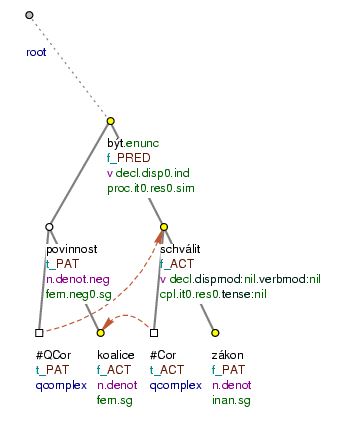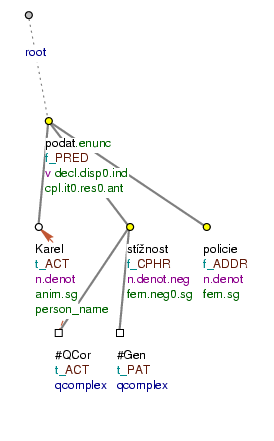Quasi-control is a specific grammatical coreference relation that can be found with multi-word predicates the dependent part of which is a noun with valency requirements (see Section 9, "Multi-word predicates"). The fact that certain combinations of a verb and noun form semantically a single unit has the consequence that the verb and noun share some of their valency modifications (or rather the modifications are identical in reference). This sharing is called quasi-control.
In the surface structure, the identical modifications are usually expressed only once; cf.:
-
Poskytl Janovi ochranu (=He offered Jan protection).
The Addressee of the verb poskytnout (=provide) as well as the Patient of the noun ochrana (=protection) has the same reference (Jan). This shared modification can only be present once at the surface level (it is impossible to say: *Poskytl Janovi ochranu Jana (=lit. Offered Jan protection (of) Jan)).
Representing quasi-control in the tectogrammatical trees. A new node is inserted into the structure - usually as a valency modification of the non-verbal part of the predicate - with the #QCor t-lemma. The identity in reference is signalled not only by the special t-lemma but also by the grammatical coreference relation between the newly established node and the other node with the same reference (the coreference relation is marked in the tree).
If none of the identical modifications is expressed at the surface level, a new node with the #QCor t-lemma is added to the structure, as a modification of the non-verbal part, and the newly established node for the same modification of the verbal part has the #Gen, #PersPron, or #Unsp t-lemma, according to the type of ellipsis (see Section 12.2, "Ellipsis of the dependent element").
Cf.:
-
{
#QCor.PAT} Povinností koalice je schválit zákon. (=The Coalition's duty is to pass the bill)The Actor of the verbal part of the verbonominal predicate, the verb schválit (=pass), is identical with the non-expressed Patient of the noun povinnost (=duty). In place of the non-expressed Patient of the non-verbal part of the predicate, a new node with the
#QCort-lemma is inserted into the structure and the grammatical coreference relation between the node and the Actor of schválit is marked in the tree. Cf. Fig. 9.84. -
Karel podal {
#QCor.ACT} stížnost policii. (=Karel lodged a complaint at the police)The Actor of the verbal part of the predicate (Karel) is identical in reference with the non-expressed Actor of the noun stížnost (=complaint). In place of the non-expressed Actor of the nominal part of the predicate, a new node with the
#QCort-lemma is inserted into the structure and the coreference relation between the node and the Actor of the verbal part of the predicate, the noun Karel, is marked in the tree. Cf. Fig. 9.85.
There is no coreference relation going to (the arrow pointing to) the node with the t-lemma #QCor.
Types of quasi-control. Quasi-control concerns two types of multi-word predicates:
-
complex predicates (see Section 9.3, "Complex predicates").
Detailed rules for representing quasi-control relations with complex predicates are to be found in Section 9.3.4.2, "Sharing of valency modifications between the verbal and nominal components (quasi-control)".
-
verbonominal predicates; i.e. být + noun in the nominative or instrumental (see Section 2.1.3, "Copula "být" (verbonominal predicate)").
!!! Quasi-control with verbonominal predicates is not represented consistently in the data; often, it is not represented at all.

